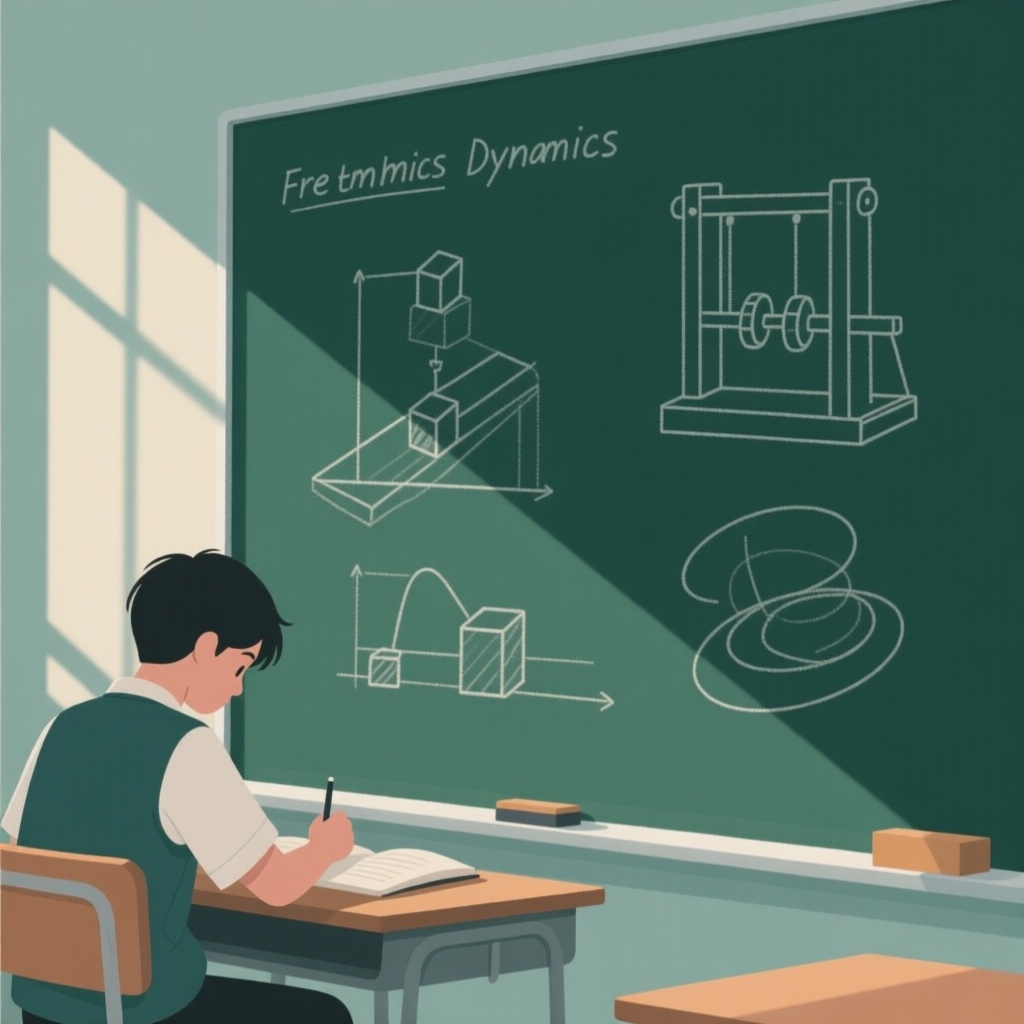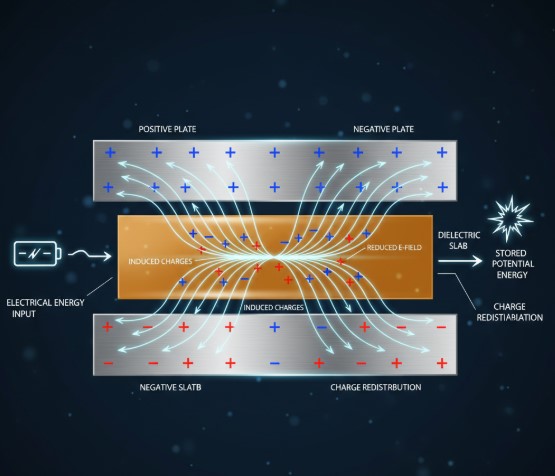INTRODUCTION: WHAT IS DYNAMICS?
Dynamics is the part of mechanics that studies how forces affect the motion of objects. While kinematics describes how things move (displacement, velocity, acceleration), dynamics explains why they move that way.
For CBSE, JEE, NEET and other exams, dynamics is built mainly on:
- Newton’s Laws of Motion
- Work–Energy Theorem
- Conservation of Momentum
- Circular Motion, and sometimes springs, pulleys, etc.
- Circular Motion, and sometimes springs, pulleys, etc.
- Circular Motion, and sometimes springs, pulleys, etc.
- Fundamental laws of physics involved in dynamics (with MathJax delimiters)
- Ten problems, from simple to challenging, with full solutions and the key laws stated for each.
- Ten problems, from simple to challenging, with full solutions and the key laws stated for each.
- Ten problems, from simple to challenging, with full solutions and the key laws stated for each.
-
Newton’s First Law (Law of Inertia)
A body remains at rest or continues in uniform straight-line motion unless acted upon by a net external force. -
Newton’s Second Law
The net force on a body equals the product of its mass and acceleration:
###\vec F_{\text{net}} = m \vec a### - Newton’s Third Law
For every action, there is an equal and opposite reaction. If body A exerts a force on body B, then body B exerts a force ##-\vec F## on A. - Weight Near Earth’s Surface (Gravitation Approximation)
Weight of a body of mass ##m## near Earth’s surface is:
###W = mg###
In numerical problems we’ll use ##g = 10\ \text{m/s}^2## for simplicity. -
Work–Energy Theorem
The net work done on a body equals the change in its kinetic energy:
###W_{\text{net}} = \Delta K = \frac{1}{2}mv^2 – \frac{1}{2}mv_0^2### -
Conservation of Mechanical Energy (only conservative forces)
Total mechanical energy (kinetic ##K## + potential ##U##) remains constant:
###K_i + U_i = K_f + U_f### -
Impulse–Momentum Theorem
Impulse is the change in momentum:
###\vec J = \Delta \vec p = \vec F_{\text{avg}} \Delta t### -
Conservation of Linear Momentum
For an isolated system (no external net force), total momentum remains constant:
###\vec p_{\text{initial}} = \vec p_{\text{final}}### -
Centripetal Force for Uniform Circular Motion
For an object of mass ##m## moving with speed ##v## on a circle of radius ##r##:
###F_c = \frac{mv^2}{r}### -
Centripetal Force for Uniform Circular Motion
For an object of mass ##m## moving with speed ##v## on a circle of radius ##r##:
###F_c = \frac{mv^2}{r}### -
Centripetal Force for Uniform Circular Motion
For an object of mass ##m## moving with speed ##v## on a circle of radius ##r##:
###F_c = \frac{mv^2}{r}### - Find the acceleration of the block.
- If it starts from rest, how far does it move in ##3\ \text{s}##?
- If it starts from rest, how far does it move in ##3\ \text{s}##?
- If it starts from rest, how far does it move in ##3\ \text{s}##?
- Find the component of its weight parallel to the incline.
- Find the acceleration of the block down the plane (take ##g = 10\ \text{m/s}^2##).
- Find the acceleration of the block down the plane (take ##g = 10\ \text{m/s}^2##).
- Find the acceleration of the block down the plane (take ##g = 10\ \text{m/s}^2##).
-
Component of weight parallel to the incline:
###W_\parallel = mg \sin\theta = 50 \sin 30^\circ = 50 \times 0.5 = 25\ \text{N}### -
Since the plane is smooth (no friction), net force along the plane is ##25\ \text{N}##.
Using Newton’s Second Law:
###F_{\text{net}} = ma \Rightarrow a = \frac{25}{5} = 5\ \text{m/s}^2### -
Since the plane is smooth (no friction), net force along the plane is ##25\ \text{N}##.
Using Newton’s Second Law:
###F_{\text{net}} = ma \Rightarrow a = \frac{25}{5} = 5\ \text{m/s}^2### -
Since the plane is smooth (no friction), net force along the plane is ##25\ \text{N}##.
Using Newton’s Second Law:
###F_{\text{net}} = ma \Rightarrow a = \frac{25}{5} = 5\ \text{m/s}^2### - Find the acceleration of the system.
- Find the tension in the string.
- Find the tension in the string.
- Find the tension in the string.
-
Treating both blocks as a single system:
###F_{\text{net}} = Ma \Rightarrow a = \frac{10}{5} = 2\ \text{m/s}^2### -
For tension, consider the ##2\ \text{kg}## block alone. The only horizontal force on it is tension ##T##:
###T = m a = 2 \times 2 = 4\ \text{N}### -
For tension, consider the ##2\ \text{kg}## block alone. The only horizontal force on it is tension ##T##:
###T = m a = 2 \times 2 = 4\ \text{N}### -
For tension, consider the ##2\ \text{kg}## block alone. The only horizontal force on it is tension ##T##:
###T = m a = 2 \times 2 = 4\ \text{N}### - What is the normal reaction (apparent weight) on the person?
- What would it be if the lift were moving downwards with the same acceleration?
- What would it be if the lift were moving downwards with the same acceleration?
- What would it be if the lift were moving downwards with the same acceleration?
-
Lift accelerating upwards. Take upward as positive. Let ##N## be the normal reaction:
###N – mg = ma \Rightarrow N = m(g + a) = 60(10 + 2) = 60 \times 12 = 720\ \text{N}### -
Lift accelerating downwards:
###mg – N = ma \Rightarrow N = m(g – a) = 60(10 – 2) = 60 \times 8 = 480\ \text{N}### -
Lift accelerating downwards:
###mg – N = ma \Rightarrow N = m(g – a) = 60(10 – 2) = 60 \times 8 = 480\ \text{N}### -
Lift accelerating downwards:
###mg – N = ma \Rightarrow N = m(g – a) = 60(10 – 2) = 60 \times 8 = 480\ \text{N}### - How much work is done on the block?
- What is its final speed?
- What is its final speed?
- What is its final speed?
-
Work done by the force:
###W = Fd = 20 \times 5 = 100\ \text{J}### -
Initial kinetic energy ##K_i = 0## (starts from rest). By Work–Energy Theorem:
###W_{\text{net}} = \Delta K = K_f – K_i = K_f###
So:
###K_f = 100 = \frac{1}{2} m v^2 = \frac{1}{2} \cdot 4 \cdot v^2 = 2 v^2###
Hence:
###2 v^2 = 100 \Rightarrow v^2 = 50 \Rightarrow v = \sqrt{50} \approx 7.07\ \text{m/s}### -
Initial kinetic energy ##K_i = 0## (starts from rest). By Work–Energy Theorem:
###W_{\text{net}} = \Delta K = K_f – K_i = K_f###
So:
###K_f = 100 = \frac{1}{2} m v^2 = \frac{1}{2} \cdot 4 \cdot v^2 = 2 v^2###
Hence:
###2 v^2 = 100 \Rightarrow v^2 = 50 \Rightarrow v = \sqrt{50} \approx 7.07\ \text{m/s}### -
Initial kinetic energy ##K_i = 0## (starts from rest). By Work–Energy Theorem:
###W_{\text{net}} = \Delta K = K_f – K_i = K_f###
So:
###K_f = 100 = \frac{1}{2} m v^2 = \frac{1}{2} \cdot 4 \cdot v^2 = 2 v^2###
Hence:
###2 v^2 = 100 \Rightarrow v^2 = 50 \Rightarrow v = \sqrt{50} \approx 7.07\ \text{m/s}### - Find the acceleration of the system.
- Find the tension in the string.
- Find the tension in the string.
- Find the tension in the string.
-
Acceleration:
###a = \frac{F_{\text{net}}}{M} = \frac{20}{10} = 2\ \text{m/s}^2### -
Tension ##T##: consider ##m_1## (going up):
###T – m_1 g = m_1 a \Rightarrow T = m_1(g + a) = 4(10 + 2) = 48\ \text{N}###
Check with ##m_2##:
###m_2 g – T = m_2 a \Rightarrow T = m_2(g – a) = 6(10 – 2) = 48\ \text{N}### -
Tension ##T##: consider ##m_1## (going up):
###T – m_1 g = m_1 a \Rightarrow T = m_1(g + a) = 4(10 + 2) = 48\ \text{N}###
Check with ##m_2##:
###m_2 g – T = m_2 a \Rightarrow T = m_2(g – a) = 6(10 – 2) = 48\ \text{N}### -
Tension ##T##: consider ##m_1## (going up):
###T – m_1 g = m_1 a \Rightarrow T = m_1(g + a) = 4(10 + 2) = 48\ \text{N}###
Check with ##m_2##:
###m_2 g – T = m_2 a \Rightarrow T = m_2(g – a) = 6(10 – 2) = 48\ \text{N}### - The acceleration of the wedge.
- The horizontal and vertical components of the block’s acceleration relative to the ground.
- The horizontal and vertical components of the block’s acceleration relative to the ground.
- The horizontal and vertical components of the block’s acceleration relative to the ground.
- Newton’s Second Law (block and wedge)
- Newton’s Third Law
- Conservation of horizontal momentum of the system
- Relative acceleration geometry along the incline
- Relative acceleration geometry along the incline
- Relative acceleration geometry along the incline
-
Acceleration of block relative to the wedge (down the incline):
###a_{\text{rel}} = g \sin\theta### -
Horizontal acceleration of the wedge:
###a_W = \frac{m g \sin\theta \cos\theta}{M + m}### -
Horizontal acceleration of the wedge:
###a_W = \frac{m g \sin\theta \cos\theta}{M + m}### -
Horizontal acceleration of the wedge:
###a_W = \frac{m g \sin\theta \cos\theta}{M + m}### - The wedge’s horizontal acceleration ##a_W##
- The block’s relative acceleration down the incline (magnitude ##a_{\text{rel}} = 5\ \text{m/s}^2##) resolved into horizontal and vertical components
- The block’s relative acceleration down the incline (magnitude ##a_{\text{rel}} = 5\ \text{m/s}^2##) resolved into horizontal and vertical components
- The block’s relative acceleration down the incline (magnitude ##a_{\text{rel}} = 5\ \text{m/s}^2##) resolved into horizontal and vertical components
- Horizontal component: ##a_{\text{rel}} \cos\theta = 5 \cos 30^\circ \approx 5 \cdot 0.866 = 4.33\ \text{m/s}^2## (towards right)
- Vertical component: ##a_{\text{rel}} \sin\theta = 5 \sin 30^\circ = 5 \cdot 0.5 = 2.5\ \text{m/s}^2## (downwards)
- Vertical component: ##a_{\text{rel}} \sin\theta = 5 \sin 30^\circ = 5 \cdot 0.5 = 2.5\ \text{m/s}^2## (downwards)
- Vertical component: ##a_{\text{rel}} \sin\theta = 5 \sin 30^\circ = 5 \cdot 0.5 = 2.5\ \text{m/s}^2## (downwards)
- Horizontal: ##5.2\ \text{m/s}^2## (to the right)
- Vertical: ##2.5\ \text{m/s}^2## (downwards)
- Vertical: ##2.5\ \text{m/s}^2## (downwards)
- Vertical: ##2.5\ \text{m/s}^2## (downwards)
- The core dynamics laws expressed using your MathJax delimiters (##inline## and ###block###).
- Ten carefully graded problems, each mapped to specific laws such as Newton’s laws, friction, circular motion, and energy conservation.
- Ten carefully graded problems, each mapped to specific laws such as Newton’s laws, friction, circular motion, and energy conservation.
- Ten carefully graded problems, each mapped to specific laws such as Newton’s laws, friction, circular motion, and energy conservation.
Below you’ll find:
FUNDAMENTAL LAWS USED IN THIS BLOG
We’ll explicitly mention which of these are used in each problem.
PROBLEM 1 – CONSTANT FORCE ON A BLOCK (VERY EASY)
A horizontal force of ##10\ \text{N}## acts on a block of mass ##2\ \text{kg}## resting on a smooth (frictionless) horizontal surface.
Laws involved: Newton’s Second Law, constant-acceleration kinematics.
Solution
Net force: ##F = 10\ \text{N}##, mass: ##m = 2\ \text{kg}##.
Using Newton’s Second Law:
###F = ma \Rightarrow a = \frac{F}{m} = \frac{10}{2} = 5\ \text{m/s}^2###
Now use kinematics (initial velocity ##u = 0##, time ##t = 3\ \text{s}##, acceleration ##a = 5\ \text{m/s}^2##):
###s = ut + \frac{1}{2}at^2 = 0 \cdot 3 + \frac{1}{2} \cdot 5 \cdot 3^2
= \frac{1}{2} \cdot 5 \cdot 9 = 22.5\ \text{m}###
So, distance moved in 3 s is 22.5 m.
PROBLEM 2 – BLOCK ON A FRICTIONLESS INCLINE (EASY)
A block of mass ##5\ \text{kg}## is placed on a smooth incline making an angle ##30^\circ## with the horizontal.
Laws involved: Newton’s Second Law, resolving forces.
Solution
Weight of the block:
###W = mg = 5 \times 10 = 50\ \text{N}###
So, acceleration down the incline is ##5\ \text{m/s}^2##.
PROBLEM 3 – INCLINE WITH FRICTION (EASY–MODERATE)
Same situation as Problem 2, but now the coefficient of kinetic friction between the block and plane is ##\mu_k = 0.2##. Find the acceleration of the block down the plane.
Laws involved: Newton’s Second Law, friction force ##f_k = \mu_k N##.
Solution
Normal reaction on the block:
###N = mg \cos\theta = 50 \cos 30^\circ \approx 50 \times 0.866 \approx 43.3\ \text{N}###
Kinetic friction (up the plane):
###f_k = \mu_k N \approx 0.2 \times 43.3 \approx 8.66\ \text{N}###
Net force down the plane:
###F_{\text{net}} = W_\parallel – f_k = 25 – 8.66 \approx 16.34\ \text{N}###
Acceleration:
###a = \frac{F_{\text{net}}}{m} \approx \frac{16.34}{5} \approx 3.27\ \text{m/s}^2###
So acceleration is approximately ##3.3\ \text{m/s}^2## down the plane.
PROBLEM 4 – TWO BLOCKS CONNECTED BY A STRING (MODERATE)
Two blocks of masses ##3\ \text{kg}## and ##2\ \text{kg}## lie on a smooth horizontal surface, connected by a light inextensible string. A horizontal force of ##10\ \text{N}## pulls the ##3\ \text{kg}## block.
Laws involved: Newton’s Second Law (system of particles), Newton’s Third Law (tension).
Solution
Total mass:
###M = 3 + 2 = 5\ \text{kg}###
So, acceleration is ##2\ \text{m/s}^2##, tension is ##4\ \text{N}##.
PROBLEM 5 – APPARENT WEIGHT IN AN ELEVATOR (MODERATE)
A person of mass ##60\ \text{kg}## stands in a lift. The lift moves upwards with an acceleration of ##2\ \text{m/s}^2##.
Take ##g = 10\ \text{m/s}^2##.
Laws involved: Newton’s Second Law, apparent weight concept.
Solution
Actual weight:
###W = mg = 60 \times 10 = 600\ \text{N}###
So apparent weight is 720 N (going up) and 480 N (going down).
PROBLEM 6 – WORK–ENERGY WITH CONSTANT FORCE (MODERATE)
A ##4\ \text{kg}## block is initially at rest on a frictionless horizontal surface. A constant horizontal force of ##20\ \text{N}## acts on it over a distance of ##5\ \text{m}##.
Laws involved: Work–Energy Theorem.
Solution
So the final speed is about ##7.1\ \text{m/s}##.
PROBLEM 7 – ATWOOD MACHINE (TWO MASSES OVER A PULLEY) (MODERATE–HARD)
Two masses, ##m_1 = 4\ \text{kg}## and ##m_2 = 6\ \text{kg}##, are connected by a light string over a frictionless pulley (Atwood machine).
Take ##g = 10\ \text{m/s}^2##.
Laws involved: Newton’s Second Law for each mass, Newton’s Third Law.
Solution
Heavier mass ##m_2## goes down, lighter mass ##m_1## goes up.
Net driving force:
###F_{\text{net}} = m_2 g – m_1 g = (m_2 – m_1) g = (6 – 4) \times 10 = 20\ \text{N}###
Total mass:
###M = m_1 + m_2 = 4 + 6 = 10\ \text{kg}###
So, acceleration is ##2\ \text{m/s}^2##, tension is ##48\ \text{N}##.
PROBLEM 8 – CAR ON A CURVED ROAD (CIRCULAR MOTION) (HARD)
A car of mass ##1000\ \text{kg}## moves on a flat horizontal road that curves with radius ##50\ \text{m}##. The coefficient of static friction between tyres and road is ##\mu_s = 0.5##.
Find the maximum speed at which the car can take the turn without skidding.
Take ##g = 10\ \text{m/s}^2##.
Laws involved: Uniform circular motion, friction providing centripetal force, Newton’s Second Law.
Solution
Maximum frictional force:
###f_{\max} = \mu_s N = \mu_s mg = 0.5 \times 1000 \times 10 = 5000\ \text{N}###
This acts as the centripetal force:
###\frac{mv^2}{r} \le f_{\max} \Rightarrow \frac{1000 v^2}{50} \le 5000###
Thus:
###20 v^2 \le 5000 \Rightarrow v^2 \le \frac{5000}{20} = 250 \Rightarrow v \le \sqrt{250} \approx 15.81\ \text{m/s}###
Convert to km/h:
###v \approx 15.81 \times 3.6 \approx 56.9\ \text{km/h}###
So, max safe speed is about ##57\ \text{km/h}##.
PROBLEM 9 – SPRING–BLOCK SYSTEM (ENERGY CONSERVATION) (HARD)
A block of mass ##2\ \text{kg}## rests on a smooth horizontal surface and is attached to a spring of force constant ##k = 200\ \text{N/m}##. The spring is compressed by ##0.10\ \text{m}## and released.
Find the speed of the block as it passes through the spring’s natural (unstretched) length.
Laws involved: Conservation of mechanical energy, spring potential energy.
Solution
Initially, spring compression ##x = 0.10\ \text{m}##, block at rest.
Spring potential energy:
###U_i = \frac{1}{2} k x^2 = \frac{1}{2} \cdot 200 \cdot (0.10)^2 = 100 \cdot 0.01 = 1\ \text{J}###
Initial kinetic energy ##K_i = 0##.
At natural length: ##x = 0##, so ##U_f = 0##, and let kinetic energy be ##K_f = \frac{1}{2} m v^2##.
Conservation of energy:
###K_i + U_i = K_f + U_f \Rightarrow 0 + 1 = \frac{1}{2} \cdot 2 \cdot v^2 + 0###
Hence:
###1 = v^2 \Rightarrow v = 1\ \text{m/s}###
So the speed at the natural length is ##1\ \text{m/s}##.
PROBLEM 10 – BLOCK ON A MOVING WEDGE (CHALLENGING)
A smooth wedge of mass ##M = 8\ \text{kg}## rests on a smooth horizontal surface. A small block of mass ##m = 2\ \text{kg}## is placed on the incline of the wedge (angle ##\theta = 30^\circ##) and released from rest. There is no friction anywhere.
Find:
Take ##g = 10\ \text{m/s}^2##.
Laws involved:
Key Ideas (Short Version)
The block slides down the incline with acceleration relative to the wedge ##a_{\text{rel}}## along the plane. The wedge itself accelerates horizontally because the block exerts a reaction on it. No external horizontal forces act, so the horizontal momentum of the block–wedge system is conserved.
For a wedge of mass ##M## and block of mass ##m## on a smooth incline of angle ##\theta##, the known results are:
Substitution and Final Values
Substitute ##m = 2##, ##M = 8##, ##\theta = 30^\circ##, ##g = 10##.
First,
###\sin 30^\circ = 0.5,\quad \cos 30^\circ \approx 0.866###
Relative acceleration down the plane:
###a_{\text{rel}} = g \sin\theta = 10 \times 0.5 = 5\ \text{m/s}^2###
Horizontal acceleration of wedge:
###a_W = \frac{m g \sin\theta \cos\theta}{M + m} =
\frac{2 \cdot 10 \cdot 0.5 \cdot 0.866}{8 + 2} =
\frac{10 \cdot 0.866}{10} \approx 0.866\ \text{m/s}^2###
So the wedge accelerates horizontally with ##0.866\ \text{m/s}^2##.
Now, the block’s acceleration relative to ground is the vector sum of:
Let the incline make angle ##\theta## with the horizontal. The block’s acceleration relative to the wedge has:
The total horizontal acceleration of the block relative to ground:
###a_{bx} = a_W + a_{\text{rel}} \cos\theta \approx 0.866 + 4.33 \approx 5.20\ \text{m/s}^2###
The vertical acceleration (downwards) of the block:
###a_{by} = a_{\text{rel}} \sin\theta = 2.5\ \text{m/s}^2###
So, relative to the ground, the block’s acceleration components are approximately:
CLOSING REMARKS
In this blog you saw:








0 Comments